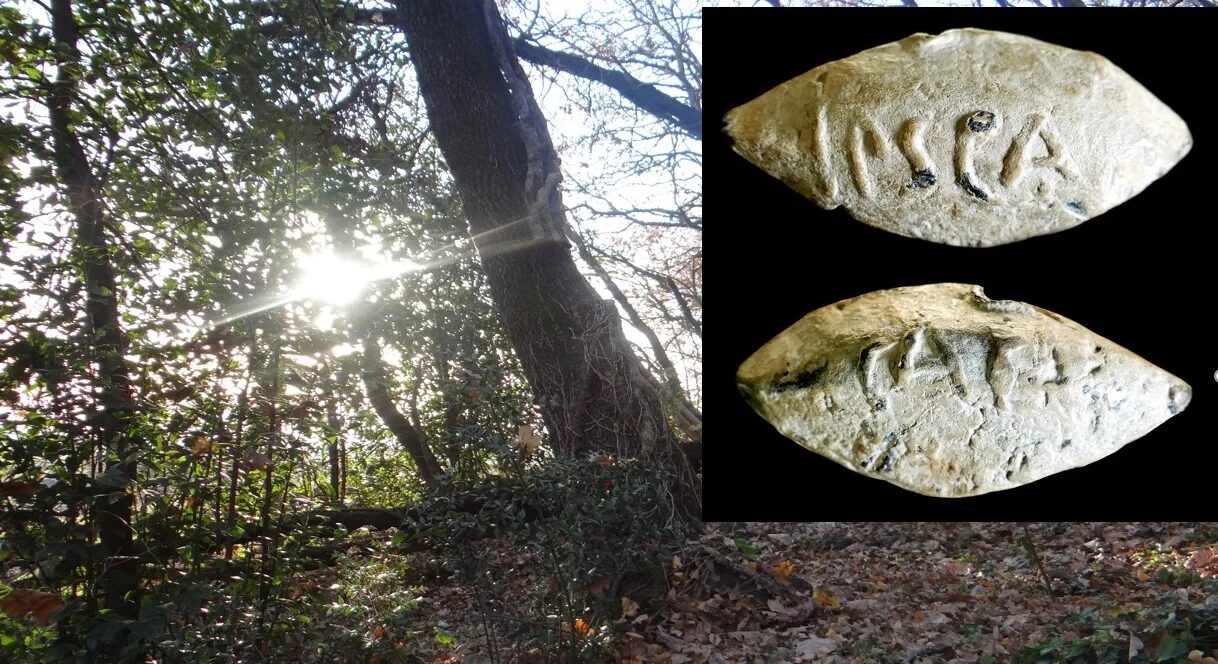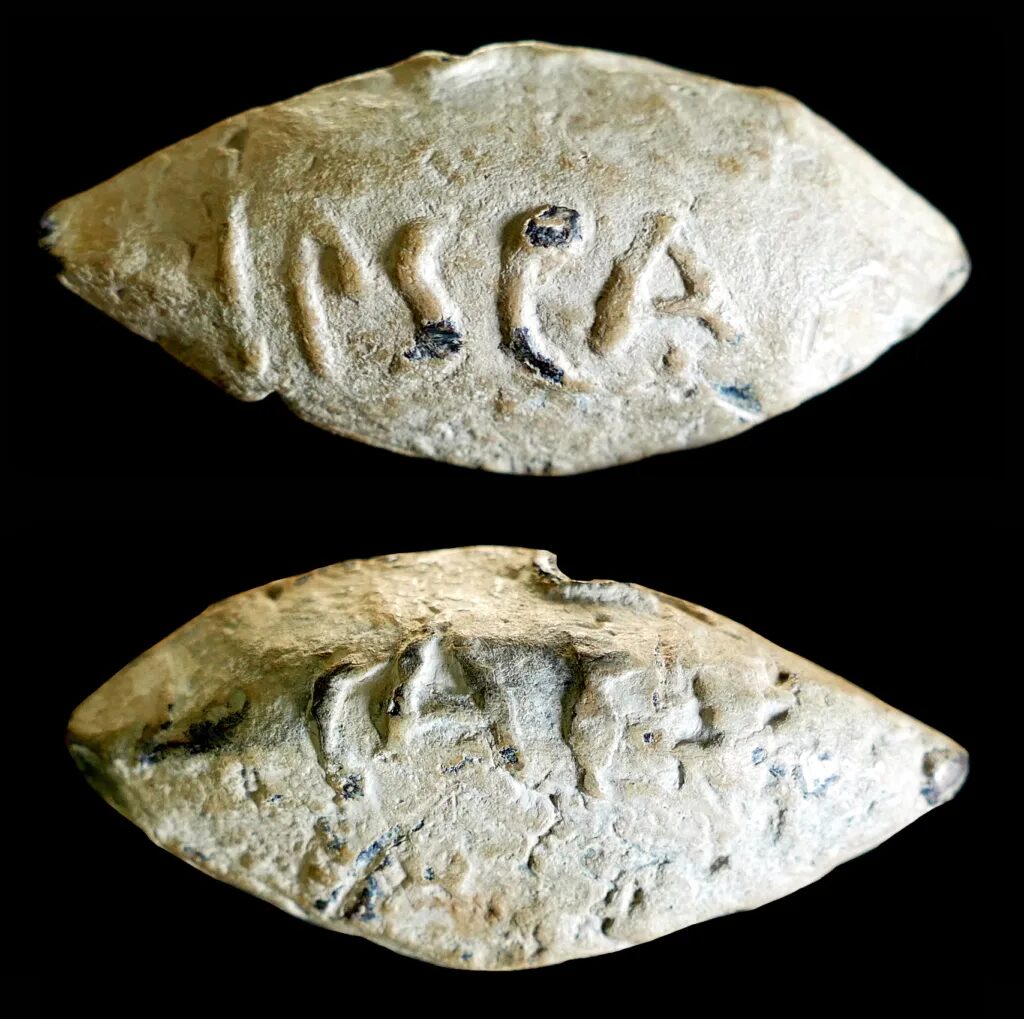
© Stile arte
and recently found in a Spanish agricultural field allows us to enrich our knowledge of the complex chessboard of municipal alliances during the civil war which supposedly brought the general who had subdued Gaul. The projectile (
pictured ) is shaped like an acorn, with pointed ends. It measures 4.5 centimeters long, 2 centimeters wide and 1.7 centimeters high. It weighs 71.1 grams. And it bears two inscriptions, in relief.
The discovery and study of the bullet were presented during a press conference held in recent hours by the municipality of Baena, in Andalusia. Why Baena? Because two writings appear on the bullet:
Cesare - CAES (ar), in the inscription - and
Ipsca - IPSCA, in the inscription -, a Roman city that stood on the border of what is now the territory of Baena.
The lead acorn was found 19 kilometers from Baena, in the countryside of Montilla, a Spanish municipality of around 23 thousand inhabitants, located in the autonomous community of Andalusia. The town is located at an average height of 372 meters above sea level and 49 kilometers from Cordoba. The terrible final clash of the civil war probably took place in his campaigns - the battle of Munda - which brought Julius Caesar here against the sons of Pompey, in 45 BC
Municipal military forces also took part in this huge battle, taking sides on one side or the other. The bullet found bears - associated - the name of Ipsca, precisely - and that - abbreviated - of Julius Caesar. Lead has now torn a veil, opening the scenario to new discoveries, to the knowledge of new alliances, strengthening the hypothesis relating to the place where the final clash between Caesar and Pompey's sons took place, in that fateful spring of 45 BC. Not only . The finding also opens a discussion relating to the most ancient roots of the term sponsorship, i.e. financing and aid for unity of purpose, support from a third party for self-promotion. Ultimately the lead acorn represents all of this.

© Stile arte
The discovery was possible thanks to the in-depth study of the projectile conducted by Javier Moralejo and Jesúss Robles of the Autonomous University of Madrid, together with
Antonio Moreno of the Archaeological Museum of Cabra and
José Antonio Morena of the Museo Histórico of Baena. Their work has now been published in the scientific journal
Zephyrus of the University of Salamanca.
Lead bullets? Yes, they were used by slingers, shooters with slingshots who achieved great precision throws against the enemy. A handful of slingers allowed the "machine gunning" of the opponents. The slingers - who were attached to the infantry - also acted as sharpshooters.
The projectiles used by the ancient Romans have a biconical shape and are similar to the bottom sinkers used today in sport fishing. The aerodynamic shape and balance in the air allowed the shot to cover considerable distances in force, to arrive on the target very often head on and to penetrate the enemy's body. They were produced by pouring molten lead into ceramic molds which bore the name of the legion by which they would have been used. It should be underlined that the bullet production operations were not particularly complex and that lead melts at a relatively low temperature, around 327 degrees.
In the case of the Spanish bullet, the name of a Spanish city, Ipsca, appears, associated with the abbreviation of Caesar's name. This means that the municipality of Ipsca had made a precise choice of side, openly siding, during the civil war, with the great general against Pompey Magnus, Cneo and Sesto.
Certainly Ipsca produced ammunition for Caesar, sealing an unbreakable alliance on lead. It was a real sponsorship, that is, a strong sharing of the cause. Hipsca espoused Caesar's cause. And he wanted to publicly underline it, marking the operation with his own name, so that there would be no doubts. The municipality probably also sent its own men to reinforce the Caesarian army in view of the clash at Munda, near present-day Montilla, the territory in which the projectile was found. Ipsca stood - as we have said - about twenty kilometers from Munda and the site of the battle. What thanks did the city then receive from Caesar? We do not know. But certainly the leaders of the urban settlement had to be tangibly rewarded.
The Roman civil war of 49-45 BC, which saw the conflict between Caesar and Pompey, was characterized by a series of both political and military clashes. Gaius Julius Caesar and his supporters had found themselves faced with the traditionalist and conservative faction of the Roman Senate, known as the Optimates. The latter was led by prominent figures such as Gnaeus Pompeius Magnus, Marcus Porcius Catone Uticensis and Quintus Cecilius Metellus Pius Scipio Nasica. At the end of 46 BC Caesar was forced to go to Spain, where the Pompeians had once again reorganized under the command of the survivors of the African war, Pompey's two sons, Gnaeus the Younger and Sextus, and Titus Labienus. It was the most difficult and bloodiest of all the campaigns of the long civil war, in which the usual clemency gave way to brutal cruelty on both sides. The war ended with the Battle of Munda, in April 45 BC, in which Caesar finally faced his opponents on the field, and defeated them irreparably. It was, however,
the most dangerous of the battles fought by Caesar, who even went so far as to despair of victory and think of killing himself.Ipsca, located on the Cerro de la Aldea near the Izcar farm, near Baena, is 9 km south in a straight line from Torreparedones, another Roman city of which important vestiges remain. Torreparedones also sided with Cesare. Detailed information on war activities is obtained mainly from the Bellum Hispaniense, which reveals that the Cordobese campaign was the scene of intense battles, involving cities such as Ategua, Ucubi, Ulia, Soricaria and many others.
The importance of the discovery of the lead bullet lies in the fact that it provides additional details not present in ancient sources, such as the
Bellum Hispaniense. Ipsca, previously absent from this history book, emerges as a city that actively supported Julius Caesar during the war, along with other cities such as Obulco (Porcuna) or Ulia (Montemayor), contributing not only with ammunition but perhaps also with sending military contingents. In this way, archaeology continues to provide crucial information that enriches our understanding of the past and the complexity of ancient alliances and conflicts.
Comment: For fascinating insight into who Caesar really was, see:
- Ultra-rare coin celebrating Julius Caesar's assassination sells for a record $3.5 million
- Laughably fake 'reconstruction' of Julius Caesar's face unveiled by Dutch archaeologist
- 'As important as the scientific discoveries of Darwin and Galileo': Linguist Francesco Carotta proves real identity of 'Jesus Christ' to be Julius Caesar
And check out SOTT radio's: